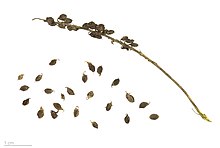Melilotus albus
| Melilotus albus | |
|---|---|

| |
| Scientific classification | |
| Kingdom: | Plantae |
| Clade: | Tracheophytes |
| Clade: | Angiosperms |
| Clade: | Eudicots |
| Clade: | Rosids |
| Order: | Fabales |
| Family: | Fabaceae |
| Subfamily: | Faboideae |
| Genus: | Melilotus |
| Species: | M. albus
|
| Binomial name | |
| Melilotus albus | |

Melilotus albus (Bokhara clover, honey clover, tree clover, sweet clover, white-flowered sweet clover, white sweet clover, white melilot), is a legume sometimes grown for forage. White sweet clover is a major source of nectar for an apiary. Its characteristic sweet odour, intensified by drying, is derived from coumarin.
Chemical constituents
It has been used in herbal medicine. It includes dicoumarol, which is an anticoagulant. It also has a high sugar content.
Habitat
White sweet clover is native to Europe and Asia. It was introduced to North America in the 17th century for cattle forage purposes and is now widespread throughout Canada and the United States, where it has become invasive and can outcompete native plant species. White sweet clover can grow up to 2 meters in height and can produce abundant amounts of seeds that readily float and disperse in water. This has allowed the plant to colonize natural habitat such as riparian areas all across much of North America.
Uses
It is favored for honey production and for its nitrogen fixing ability in preparing agricultural soil for future crops.
